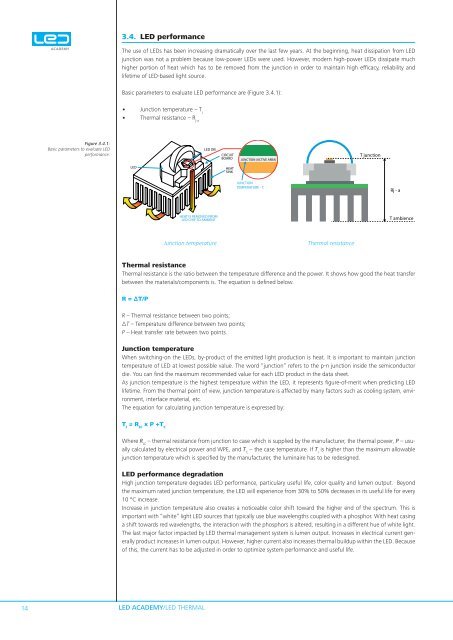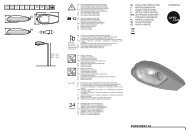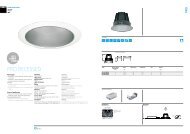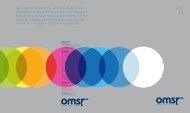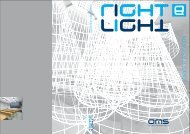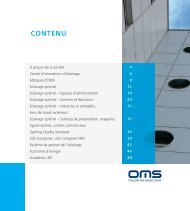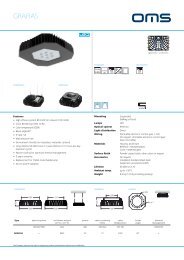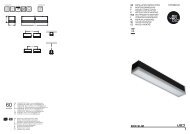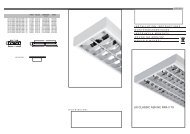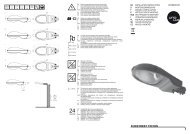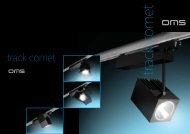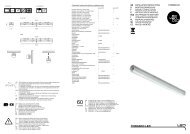Create successful ePaper yourself
Turn your PDF publications into a flip-book with our unique Google optimized e-Paper software.
3.4. <strong>LED</strong> performanceThe use of <strong>LED</strong>s has been increasing dramatically over the last few years. At the beginning, heat dissipation from <strong>LED</strong>junction was not a problem because low-power <strong>LED</strong>s were used. However, modern high-power <strong>LED</strong>s dissipate muchhigher portion of heat which has to be removed from the junction in order to maintain high efficacy, reliability andlifetime of <strong>LED</strong>-based light source.Basic parameters to evaluate <strong>LED</strong> performance are (Figure 3.4.1):• Junction temperature – T j• Thermal resistance – R j-aFigure 3.4.1:Basic parameters to evaluate <strong>LED</strong>performance.<strong>LED</strong> DIECIRCUITBOARDJUNCTION (ACTIVE AREA)T junction<strong>LED</strong>HEATSINKJUNCTIONTEMPERATURE - TjRj - aHEAT IS REMOVED FROM<strong>LED</strong> CHIP TO AMBIENTT ambienceJunction temperatureThermal resistanceThermal resistanceThermal resistance is the ratio between the temperature difference and the power. It shows how good the heat transferbetween the materials/components is. The equation is defined below.R = ΔT/PR – Thermal resistance between two points;ΔT – Temperature difference between two points;P – Heat transfer rate between two points.Junction temperatureWhen switching-on the <strong>LED</strong>s, <strong>by</strong>-product of the emitted light production is heat. It is important to maintain junctiontemperature of <strong>LED</strong> at lowest possible value. The word “junction” refers to the p-n junction inside the semiconductordie. You can find the maximum recommended value for each <strong>LED</strong> product in the data sheet.As junction temperature is the highest temperature within the <strong>LED</strong>, it represents figure-of-merit when predicting <strong>LED</strong>lifetime. From the thermal point of view, junction temperature is affected <strong>by</strong> many factors such as cooling system, environment,interface material, etc.The equation for calculating junction temperature is expressed <strong>by</strong>:T J= R JCx P +T CWhere R JC– thermal resistance from junction to case which is supplied <strong>by</strong> the manufacturer, the thermal power, P – usuallycalculated <strong>by</strong> electrical power and WPE, and T C– the case temperature. If T Jis higher than the maximum allowablejunction temperature which is specified <strong>by</strong> the manufacturer, the luminaire has to be redesigned.<strong>LED</strong> performance degradationHigh junction temperature degrades <strong>LED</strong> performance, particulary useful life, color quality and lumen output. Beyondthe maximum rated junction temperature, the <strong>LED</strong> will experience from 30% to 50% decreases in its useful life for every10 °C increase.Increase in junction temperature also creates a noticeable color shift toward the higher end of the spectrum. This isimportant with “white” light <strong>LED</strong> sources that typically use blue wavelengths coupled with a phosphor. With heat casinga shift towards red wavelengths, the interaction with the phosphors is altered, resulting in a different hue of white light.The last major factor impacted <strong>by</strong> <strong>LED</strong> thermal management system is lumen output. Increases in electrical current generallyproduct increases in lumen output. However, higher current also increases thermal buildup within the <strong>LED</strong>. Becauseof this, the current has to be adjusted in order to optimize system performance and useful life.14<strong>LED</strong> <strong>ACADEMY</strong>/<strong>LED</strong> THERMAL


